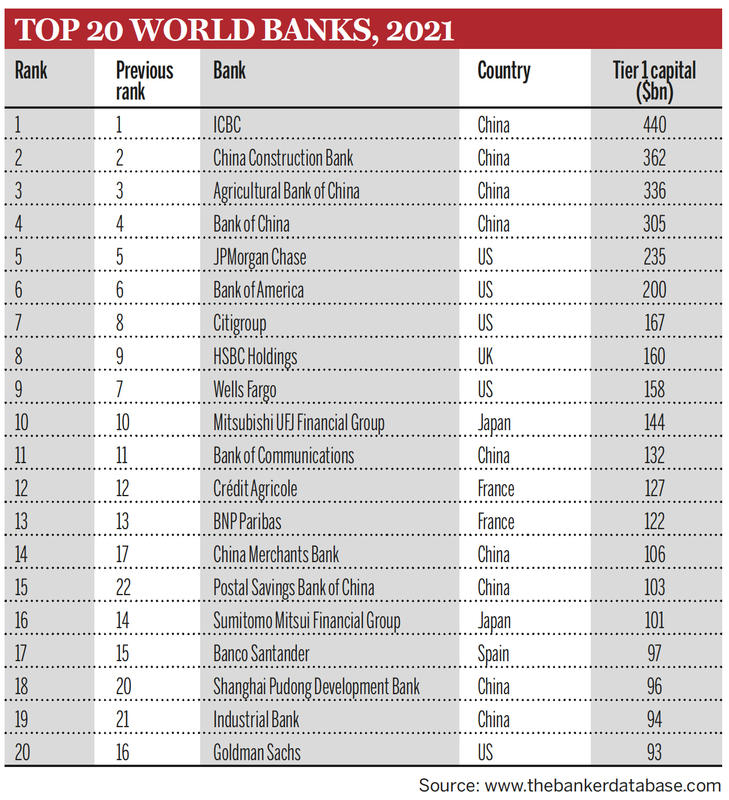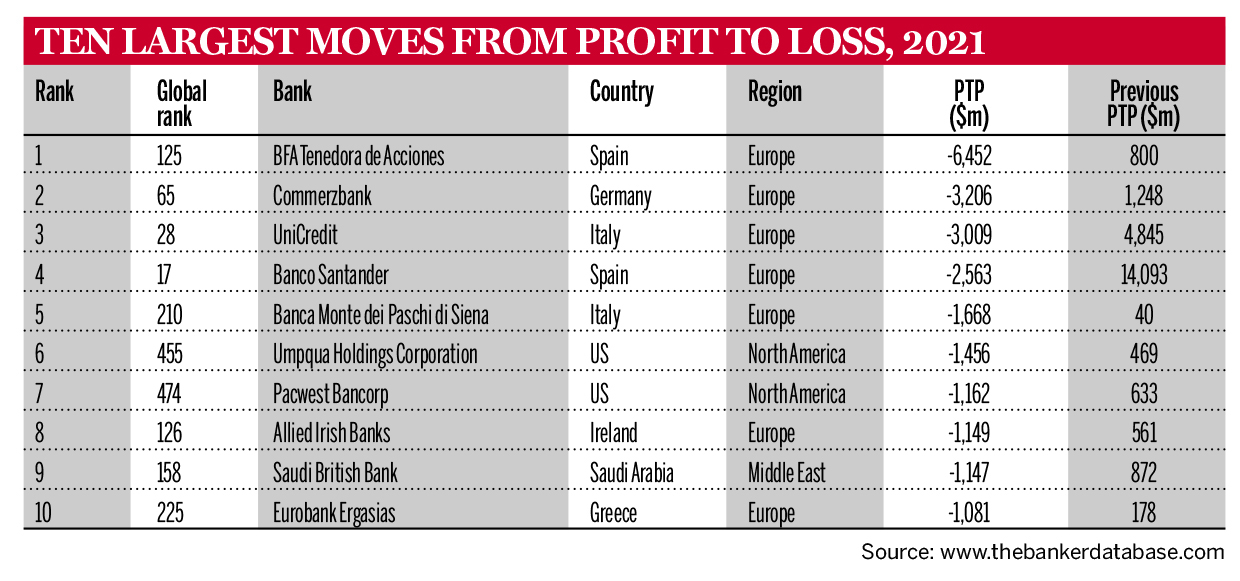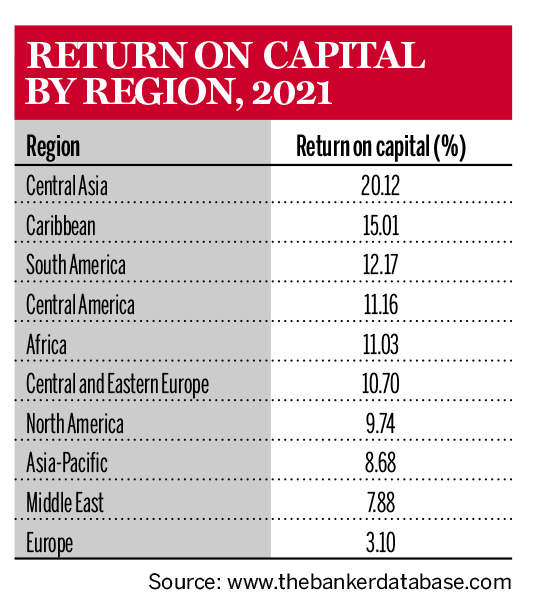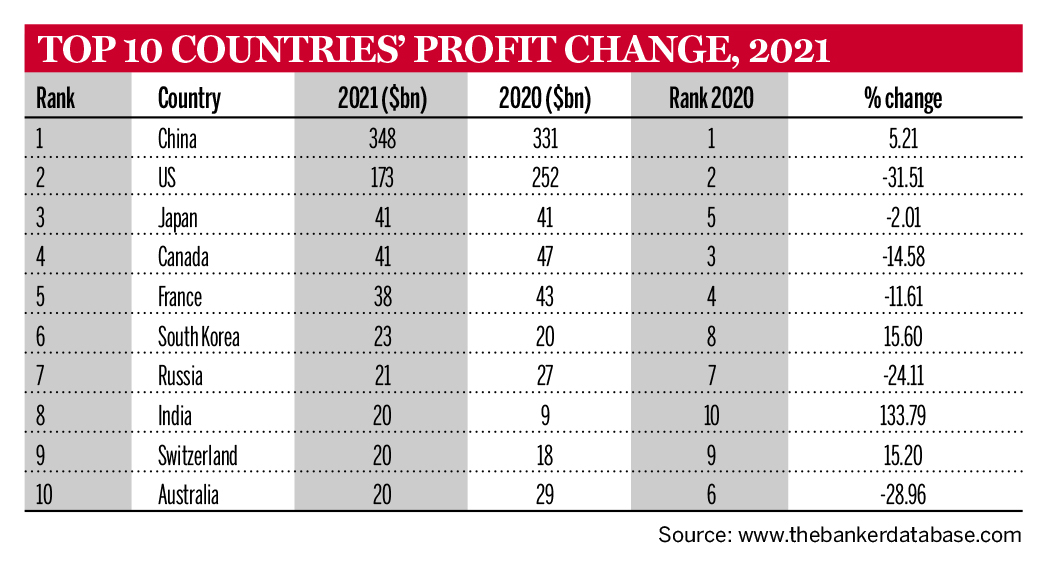28 June 2021: HSBC is the only European bank in the global top 10 list for the 10th year running, according to The Banker’s latest ranking of the Top 1000 World Banks (see Table 1). The ranking is based on Tier 1 capital, a key measure of banking strength.
The UK’s largest bank, which has strategically shifted capital to areas garnering higher returns such as Asia and wealth management, moved up one position to 8th in the global ranking and increased its Tier 1 capital by 7.96%, to $160.2bn. It also recorded a 9.91% increase in assets.
Of the top five UK banks, Lloyds Banking Group (ranked 3rd) recorded the highest percentage increase in Tier 1 capital (15.27%) year-on-year, while Barclays (ranked 2nd) topped the group in asset growth (19.93%).
However, all five banks saw declines in pre-tax profits year-on-year: -34.2% for HSBC; -28.72% for Barclays; -71.72% for Lloyds Banking Group; and -56.56% for Standard Chartered (ranked 5th). NatWest Group, in fourth place in the country ranking, moved from profit to loss.
Overall, the UK saw an aggregate 53.08% drop in profits across its banks included in the ranking.
Joy Macknight, editor of The Banker, said: “The UK banking industry has faced significant headwinds over the course of the past year, with the impacts of the Covid-19 pandemic and Brexit uncertainty weighing profitability down. Despite the challenging environment, the UK’s banking sector remains the fifth largest in the world, with aggregate Tier 1 capital of $437.5bn, underpinned by London’s position as a leading global financial centre.”
Western Europe had another difficult year due to low economic growth and the interest rate environment hitting the profitability of the region’s biggest lenders. Of the largest European economies, banks’ aggregate pre-tax profits shrank by 43.71% in Germany, 75.72% in Italy and 47.67% in the Netherlands, while France experienced a more modest decline of 11.61%. Spain recorded negative pre-tax profits at an aggregate level, with two of its largest banks, Banco Santander and Bankia, moving from profit to loss in this period (see Table 2).
The western European region now contributes 10.30% of the world’s profits, based on net income data, down from 16.37% last year and nearly one third a decade ago. Return on capital is the lowest for any region – at 3.10% (see Table 3).
Overall, the world’s largest banks have withstood the pressures from the Covid-19 pandemic, adding 12.7% to their collective Tier 1 capital to reach the highest ever level of $9.9 trillion. In addition, total assets increased by 16.0%, to $148.6 trillion, while the deposit base expanded by 17.1%, to $93.9 trillion.
Compared to the global financial crisis in 2007-09, it appears that there is more resiliency in the banking sector. Overall, the Top 1000 World Banks increased the allowance for loan losses (or the reserve to cover bad debts) by 25.8%, to $1.7 trillion, which is a larger increase than the aggregate loan book, which grew by 11.4%. However, as many jurisdictions have extended their Covid-19 support packages into 2021, the true impact of the pandemic has not yet hit the banks’ loan books.
Furthermore, while the Top 1000’s combined profits dropped by 19.2% year-on-year, it is not as catastrophic when compared to the fallout from the financial crisis, when profits plummeted 85.3% in 2009.
Joy Macknight, added: “Although profits have shrunk across the globe and many banks’ balance sheets are loaded with allowances for expected loan losses, the world’s banking industry has held up remarkably well and is better capitalised than ever before.”
China continues to be the engine of growth for the world’s banking industry, increasing aggregate Tier 1 capital and total assets by 18.6% and 18.4%, respectively. China, with 144 banks in the ranking, now holds almost double the amount of Tier 1 Capital ($2.96 trillion) as the US ($1.58 trillion), with 178 banks in the ranking. In addition, profits continued to grow in China by 5.2% year-on-year, while falling by 31.5% in the US and 41.8% in western Europe (see Table 4).
The Asia-Pacific region generated more than half (55.1%) of the world’s profits, based on net income data, up from 43.5% in the 2020 ranking, and was the only region to increase its share of profits.
|
|
|
|
|
|
|
|
-ends-
Notes
Tier 1 capital is the core measure of a bank’s financial strength under the Basel regulatory framework.
Contact
For more information, please contact:
Henry Conner I henry.conner@edelmansmithfield.com / 07709 577073
Niki Wheeler I niki.wheeler@edelman.com
Mark Staniland I mark.staniland@ft.com
About The Banker
The Banker is the world’s premier banking and finance resource, providing global financial intelligence since 1926.
The Banker is the key source of data and analysis for the industry. The Banker’s Top 1000 World Banks ranking has been setting the industry benchmark since 1970, providing comprehensive intelligence about the health and wealth of the banking sector. To find out more visit www.thebanker.com/top1000. The Banker is a service from the Financial Times.
Joy Macknight is the editor of The Banker. She joined the publication in 2015 as transaction banking and technology editor and became editor in March 2021. She has been a financial and technology journalist for more than 15 years.
About the Financial Times
The Financial Times is one of the world’s leading business news organisations, recognised internationally for its authority, integrity and accuracy. The FT has a record paying readership of more than one million, three-quarters of which are digital subscriptions. It is part of Nikkei Inc., which provides a broad range of information, news and services for the global business community.








